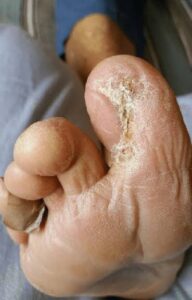The other day around 1 PM when I was about to close my morning OP, a patient aged about 45 years was brought with severe sweating, breathlessness, and painful lower limbs. On examination, he said that due to severe pain and bleeding from the cracks of heals he took several painkillers one after another. Eating too many painkillers can damage kidneys and also cause ulcers in the stomach. When I examined his blood sugar it was 60mg per dl. That condition we call hypoglycemia is a life-threatening problem. On further inquiry, the patient said that he was a diabetic. The spoiled nerves in sugar patients may not sense that they need to sweat to moisturize their feet. Heel fissures can be especially harmful in diabetics because they can lead to non-healing feet.
What Are Heel Fissures?
Heel fissures or cracks or furrows in the skin over the heels, at times, are an uncomfortable nuisance because they cause thick layers of dead skin cells to build up. Other times they can be potential triggers for painful, dangerous infections and skin damage.
Symptoms of heel fissures: Heel fissure symptoms can range from mild to severe. Brown or yellow, discoloration of the skin, which indicates, the presence of callus a hard thickening of the skin around the crack or cracks, or splitting of the skin on the heels. When left untreated, milder symptoms can become more severe, including bleeding from the cracks in the heels, open enlarged wounds or wounds on the heels, and pain when putting pressure on the heels or during walking. Heel fissures can also lead to deep ulcers (open sores) that can get infected and result in cellulitis (a painful skin infection). That’s why preventing and treating heel fissures whenever possible are so important.
What are the causes of heel fissures: Dry skin formation due to various reasons is the most common cause of heel fissures. But there are many possible reasons including Eczema, Tineapedis, a fungal infection commonly known as athlete’s foot, living in cold, dry environments, Hypothyroidism, Psoriasis, Rheumatoid Arthritis, Scieroderma, and any condition that causes tissue thickening or affecting the body’s ability to sweat can increase the risk of heel fissures.

Possible complications from heel fissures: Deep heel fissures can be very painful, and the pain can affect the quality of life. The heel fissure can also increase the stress and anxiety that the condition will worsen in those patients suffering from high blood sugar. According to a recent article published in the Journal of “Dermatological Nursing” foot ulcers from heel fissures can also lead to amputations in people with severe diabetes. This is a critical reason why it’s so important to treat heel fissures as early as possible without neglecting or depending on treatment advertisements or quack treatment.
On cracked heels, one scientific survey found that 20 percent of adults in the United States experience cracked skin on their feet. This can occur in both adults and children and seems to affect women more often than men. For most people, having cracked heels isn’t serious. It may cause discomfort when going barefoot. In some cases, cracks in the heels can become very deep and cause pain.
Other causes of cracked heels: The first sign of cracked heels is having areas of dry, thickened skin, known as callous, around the rim of the heel. On walking, the fat pad under the heel expands and causes the callous to crack. Standing for long hours, walking around barefoot, or with open-back sandals, taking long hot showers, using harsh soaps that can strip natural oils off the skin, shoes that don’t fit properly or support heels, dry skin due to climatic changes, such as cold temperatures or low humidity, are some of the causes. People who don’t moisturize their feet regularly may dry out even faster.
Medical causes to focus: High blood sugar and poor circulation resulting from diabetes are common causes of dry skin. Nerve damage may prevent from knowing feet are dry, cracked, and painful. Other conditions that may lead to dry skin and cracked heels include Vitamin Deficiency, fungal infection, hypothyroidism, juvenile plantar dermatosis, psoriasis, palmoplantar keratoderma, atopic dermatitis, cause abnormal skin thickening on the soles and palms. Obesity pregnancy and aging do contribute to cracks of the heels.
Other symptoms can accompany cracked heels: In addition to having cracked heels, one may experience, flaky skin, itching, pain, possibly severe, bleeding, red, inflamed skin, and ulceration. In severe cases, one may develop mild to severe complications with a cracked heel, especially if it’s caused by a medical condition. Complications can include a loss of feeling in the heel, cellulitis, an infection, and diabetic foot ulcers. When symptoms of infection including pain, warmth, redness, and swelling appear, a medical consultation is warranted. In the coming week permanent cure for cracks in the heels, medical management, and home remedies will be discussed.






